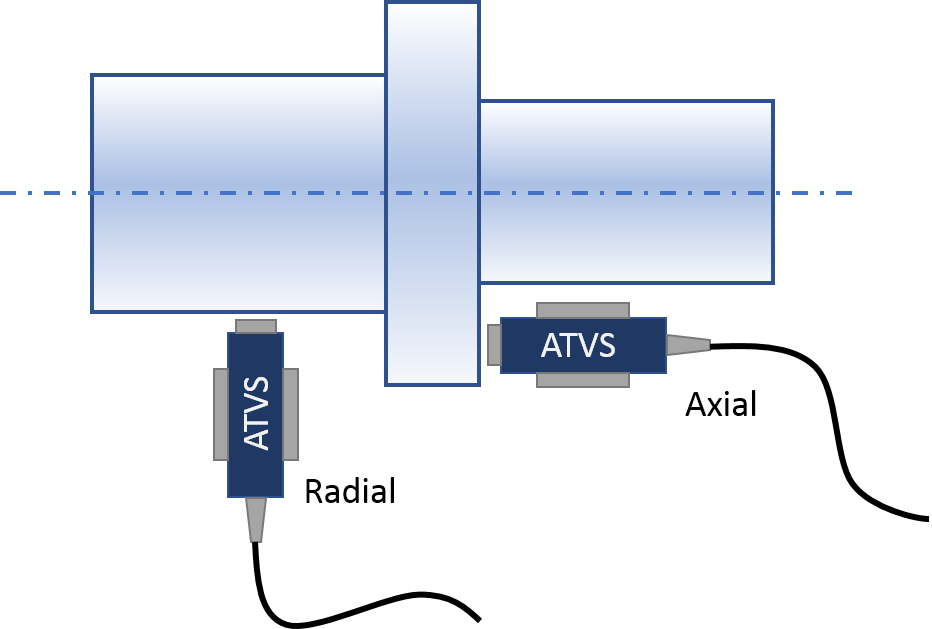Why do the Specs say that the engineering unit of the Torsional Vibration Sensor is m/sec?
The ATVS provides an analog voltage output that is proportional to the relative surface velocity of the measured shaft. This results in a Volt/(m/s) value. The measured value can be converted to an angular velocity by dividing it by the radius of the measured shaft.
What is the optimum air gap size between the ATVS and the measured shaft?
We recommend an air gap size of 10 to 40 mils (0.25 to 1mm) depending on the application. This range results in an excellent signal to noise ratio.
What is the minimum shaft/rotor size?
The shaft diameter should not be smaller than 4inch (100mm).
How can I use the “noise only” channel?
You can use the noise-only channel to identify the electrical noise in the measurements given by the active channel of the ATVS. The noise-only channel uses a nearly identical circuit to the torsional vibration measuring circuit. However, the noise-only channel cannot sense the torsional vibrations but it is exposed to the same electrostatic and electromagnetic interference. This allows the user to identify noise peaks in the frequency domain and exclude them from the measured torsional vibration data.

Will the ATVS work with a dented and scratched shaft?
The ATVS is designed for real-world application where the shaft is not perfect. The shaft can be painted, rusted, oily, scratched, engraved, indented, dirty, etc.
What temperatures are the ATVS rated for?
The ATVS’ default operating temperature is -40°C to +70°C (-40°F to +158°F).
There is a high-temperature version: ATVS-HT rated for -40°C to +200°C (-40°F to +392°F).
Is there a version of the ATVS that output current (4-20mA) instead of voltage?
Yes.
What is the lead time for a single ATVS?
The lead time is 4 weeks after the order is placed.
Can the ATVS work in high EMI/RFI environment?
The ATVS was designed to work in a high EMI/FRI environment such as near to a three-phase generator, or inside the exciter housing. The ATVS has multiple layers of electrostatic and electromagnetic shields. Additionally, any electrical noise that gets through all the shields will be identified from the data of the noise-only signal. See above: “How can I use the “noise only” channel?” section.
What is a mechanical noise and how can you ID it?
Typical mechanical noise is caused by probe vibration. If the probe is attached to a flexible base/structure (for example a coupling cover made of sheet metal), the relative vibration to the shaft will show up in the signal as torsional vibration. Since this noise is not electrical, it requires additional hardware to separate it from real torsional vibration. There is an advanced version of the ATVS available that can address this problem.
Our turbine generator is outside. Can the ATVS handle tropical storms?
Yes, the ATVS has IP65/67 ratings.
Can the ATVS be installed when the turbine-generator is on turning gear (~3RPM)?
Yes, with the proper pre-manufactured brackets the entire ATVS system can be installed in a couple of hours.
Where is the ATVS manufactured?
The ATVS is made in the USA.
Can we integrate the ATVS into our control room?
The ATVS is analog and comes in either a voltage or a 4-20 mA model. Integration into existing control systems should not be a problem.
How accurate is the ATVS?
The ATVS has a noise floor below 0.1mm/sec. That is 0.66 miliRad/s with a 12inch diameter shaft.
How difficult is it to install the ATVS?
The ATVS installation is similar to the installation of radial proximity probes such as the Bentley-Nevada prox probe. A small air gap should be maintained during operation. The difference between the prox probe and the ATVS is the ATVS is slightly bigger and requires a certain orientation to the rotational axis. The required orientation is well marked on the sensor.
Can the ATVS be installed in Axial Direction?
Yes, the ATVS can measure torsional vibration when it is positioned axially. In this configuration, the ATVS measures the relative surface velocity of the flat surface of the rotor.

